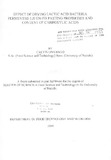| dc.description.abstract | The effect of fermentation and drying on the pasting properties and carboxylic acids of
pure flours of maize, finger millet and cassava and of composite flours of maize-finger
millet and cassava-finger millet were studied. The pasting properties were measured
between 30°C and 96°C in a Brabender Amylograph while carboxylic acids from the uji
slurries were determined on thin layer chromatography plates coated with 0.25 mm silica
gel.
Irrespective of the treatment given, the cereal flours of maize, finger millet and the
composite of maize-finger millet consistently had higher onset and peak gelatinization
temperatures than pure cassava or the composite of cassava-finger millet. Also the latter
two flours developed higher peak viscosities and disintegrated more rapidly after
attaining the peak than either pure maize, finger millet or the composite of maize-finger
millet. The higher viscosities of the root flours was also reflected in the higher swelling
powers and solubility values at 85°C. Fermentation increased the viscosity of the
slurries. The greatest increases were recorded by maize (500BU) and the composite of
maize-finger millet (780 BU). Fermentation did not affect gelatinization temperatures
except for the maize-finger millet composite whose gelatinization temperature decreased
by 10°C. Fermentation and drying resulted in increased viscosity when compared to the
non-fermented flours, except for the drum dried cassava-finger millet composite. For all
the drum dried flours there was a spontaneous increase in viscosity at 30°C when the
Brabender Amylograph was switched on. The drum dried flours absorbed about four
times their own weight of water; and since the starch granules were pregelatinized,
reconstitution in cold water was difficult, as the flour particles tended to lump together,
getting wetted on the surface and inhibiting the penetration of water into the interior. In
contrast, sun and cabinet dried flours absorbed about 1.9 times their own weight of water
and formed smooth slurries in cold water. Fermentation increased total titratable acidity
and fixed acidity of the slurries to about 3.9% and 3.6% respectively, while the pH
declined from 5.5 to 3.9. On drying there were no significant changes in (p<0.05) total
titratable acidity declined by between 20-60%; the greatest losses being experienced by
cassava and cassava finger millet. Acetic, formic and hexanoic acid were present in all
the fermented slurries while propionic acid was absent. Acetic and formic acids were
completely lost when the fermented slurries were either sun-, cabinet-, or drum dried.
Hexanoic acid declined slightly on drying but the levels were influenced by the drying
system. Consumer preferences for uji prepared from the fermented and dried slurries did
not differ significantly (p>0.05) from the uji prepared from fermented and nondehydrated
slurries. | en |

